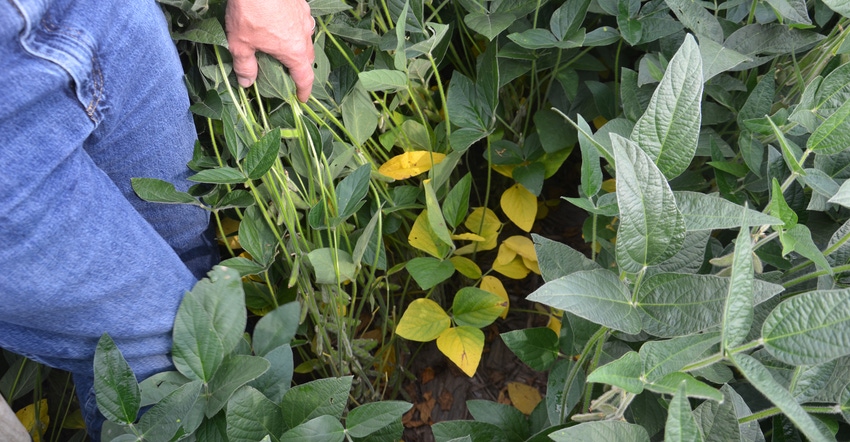
When Steve Gauck visited the Soybean Watch ’21 field in mid-July, there was still plenty of moisture. Signs of disease weren’t evident, but he told the grower that since the season had been on the wet side so far, a fungicide application would likely be a good investment. And he also advised adding an insecticide — a few grasshoppers and other insects were nibbling on leaves in July.
The grower took the advice to heart and applied a fungicide with an insecticide with his own self-propelled sprayer at the R3 stage of soybean development.
Related: Watch for sudden death syndrome in soybeans
“That’s usually the stage where we see the most benefit from applying a fungicide on soybeans when we compare it to other application times in replicated field trials,” Gauck says. Gauck is a regional agronomy manager for Beck’s, based in Greensburg, Ind. Beck’s sponsors Soybean Watch ’21.
When Gauck returned around mid-August, he was impressed at what he saw. The beans were at the R5 stage and were ready for rain but were still looking healthy at that point. They were no-tilled into cornstalks on May 15 with a split-row planter.
No disease
“When I pulled back the canopy, I saw lots of pods,” Gauck says. “Only the bottom few leaves on most plants were yellow. The secret was if they were just yellow, or yellow and filled with brown spots.
“You expect yellow leaves at the bottom of soybean plants in a dense canopy at that stage,” he says. “It’s simply due to a lack of sunlight. With such a dense canopy, very little sunlight reaches lower leaves.
“If you saw yellowish leaves with brown spots, that would indicate presence of a disease. But we didn’t find brown spots. In this case, it was just a lot of sunlight, not disease.”
Gauck quizzed the grower on how many gallons per acre of total spray volume he applied. As it turns out, he applied 18 gallons per acre.
“That’s one reason why he got good protection all the way to the base of the plants, and why we weren’t seeing disease even on lower leaves,” Gauck explains. “When you apply 15 to 20 gallons per acre with the fungicide, you get better penetration into the canopy, and the fungicide goes deeper into the plant.”
Beck’s Practical Farm Research program has included trials to compare application of a fungicide in varying amounts of total spray volume over the past couple of years, Gauck says. Applying at more than 10 gallons per acre vs. 5 gallons per acre has shown a significant advantage in effectiveness of the fungicide, as measured in higher yield.
“We also found virtually no disease at the R5 stage in the field,” he reports. “I hunted long enough until I found a leaf with a few frogeye leaf spot lesions, but it certainly was not a concern.”
He also did not see more plants affected with phytophthora root rot, although he found a few scattered plants in July.
“The fungicide would not affect them,” he says. “It will also not impact sudden death syndrome. We didn’t see SDS in this field at R5, but it has been showing up rather frequently in certain parts of Indiana, especially northern Indiana.”
About the Author(s)
You May Also Like




